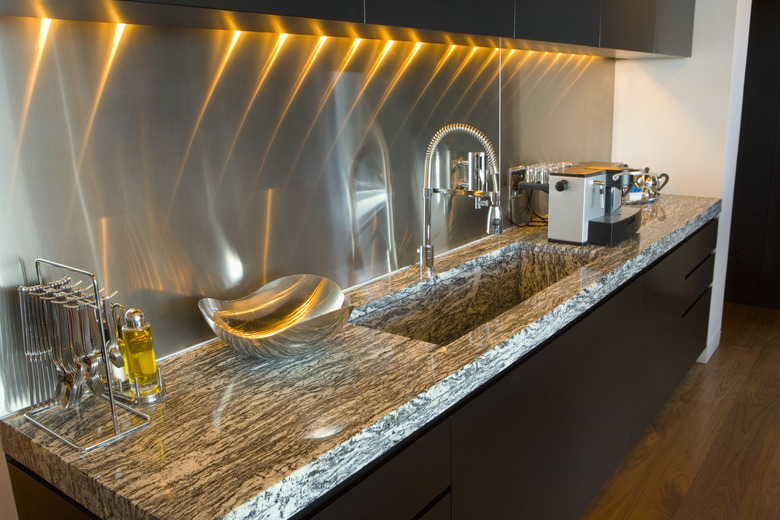Is Foliation Caused By Confining Pressure?
Rocks are divided into three basic types according to how they form. Igneous rocks such as granite and basalt crystallize as they cool from a molten state, called magma. Sedimentary rocks may form from eroded bits of older rocks, from the remains of organisms or by the evaporation of chemical-rich water. The third major rock type is metamorphic, meaning that the rocks have been changed. Metamorphic rocks, including gneiss and marble, change when extreme heat and pressure cause mineral changes through recrystallization. Many metamorphic rocks appear to be layered, an effect called foliation.
Metamorphism and Minerals
When any type of rock is exposed to high temperature, high pressure or both, the rock's mineral grains tend to change. High pressure associated with deep burial causes migration of atoms along and across grain-to-grain contacts. This migration allows mineral grains to change their shapes. When the minerals present are unstable at the ambient temperature and pressure, the migrating atoms may combine to form minerals that were not present in the original rock. These microscopic changes in mineral shape and chemistry occur even though the rock does not melt.
Foliated Metamorphic Rocks
Foliation observed in metamorphic rocks is a preferential alignment of mineral crystals, for example sheet-like minerals such as micas (muscovite and biotite) and clay minerals. This alignment creates crude layering in weakly or moderately metamorphosed rocks such as slate and schist. In gneiss, the metamorphic rock resulting from the highest temperature and pressure, larger mineral grains segregate into a characteristic banding or layering. Foliation is an identifying characteristic of some, although not all, metamorphic rocks.
Cause of Foliation
All rocks are under pressure as a result of burial. This confining pressure increases in proportion to the depth of burial. At great depths, the pressure is sufficient to cause recrystallization along grain boundaries, but because confining pressure is the same in all directions, mineral grains grown under these conditions of uniform stress do not have a preferential growth direction. A rock that recrystallizes under these conditions will consist of randomly oriented grains.
If the rock undergoing metamorphism is under conditions of directional stress, such as might occur where two tectonic plates collide, pressure is not equal in all directions. In such cases, soft mineral grains will tend to flatten perpendicular to the direction of maximum pressure. More importantly, recrystallized mineral grains growing in an environment of differential pressure are more likely to develop shapes that align with the longest dimensions perpendicular to the direction of maximum pressure. The alignment of grains results in a layered texture. This means that differential stress related to different pressure in different directions is required to form foliated metamorphic rocks.
Nonfoliated Metamorphic Rocks
Not all metamorphic rocks are foliated. Some metamorphic rocks result from "baking" by the intrusion of magma bodies. These contact metamorphic rocks do not generally show foliation because the pressure is nearly equal in all directions.
Another cause of nonfoliated metamorphic rocks is a homogeneous parent rock. Foliated rocks generally develop from parent rocks containing multiple minerals or from mixtures of multiple rock types. The nonfoliated metamorphic rocks marble and quartzite develop under conditions of differential stress when the original rocks are relatively pure and do not grow new mineral types to develop foliation.
Cite This Article
MLA
O'Donahue, Kelvin. "Is Foliation Caused By Confining Pressure?" sciencing.com, https://www.sciencing.com/foliation-caused-confining-pressure-16826/. 24 April 2017.
APA
O'Donahue, Kelvin. (2017, April 24). Is Foliation Caused By Confining Pressure?. sciencing.com. Retrieved from https://www.sciencing.com/foliation-caused-confining-pressure-16826/
Chicago
O'Donahue, Kelvin. Is Foliation Caused By Confining Pressure? last modified March 24, 2022. https://www.sciencing.com/foliation-caused-confining-pressure-16826/
